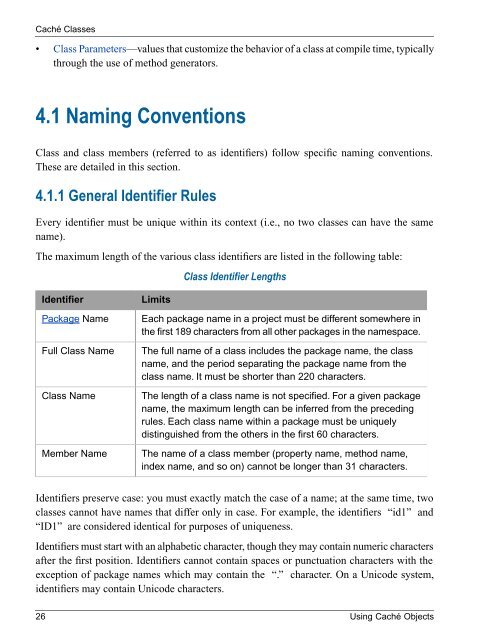Using Caché Objects - InterSystems Documentation
Using Caché Objects - InterSystems Documentation
Using Caché Objects - InterSystems Documentation
You also want an ePaper? Increase the reach of your titles
YUMPU automatically turns print PDFs into web optimized ePapers that Google loves.
<strong>Caché</strong> Classes<br />
• Class Parameters—values that customize the behavior of a class at compile time, typically<br />
through the use of method generators.<br />
4.1 Naming Conventions<br />
Class and class members (referred to as identifiers) follow specific naming conventions.<br />
These are detailed in this section.<br />
4.1.1 General Identifier Rules<br />
Every identifier must be unique within its context (i.e., no two classes can have the same<br />
name).<br />
The maximum length of the various class identifiers are listed in the following table:<br />
Class Identifier Lengths<br />
Identifier<br />
Package Name<br />
Full Class Name<br />
Class Name<br />
Member Name<br />
Limits<br />
Each package name in a project must be different somewhere in<br />
the first 189 characters from all other packages in the namespace.<br />
The full name of a class includes the package name, the class<br />
name, and the period separating the package name from the<br />
class name. It must be shorter than 220 characters.<br />
The length of a class name is not specified. For a given package<br />
name, the maximum length can be inferred from the preceding<br />
rules. Each class name within a package must be uniquely<br />
distinguished from the others in the first 60 characters.<br />
The name of a class member (property name, method name,<br />
index name, and so on) cannot be longer than 31 characters.<br />
Identifiers preserve case: you must exactly match the case of a name; at the same time, two<br />
classes cannot have names that differ only in case. For example, the identifiers “id1” and<br />
“ID1” are considered identical for purposes of uniqueness.<br />
Identifiers must start with an alphabetic character, though they may contain numeric characters<br />
after the first position. Identifiers cannot contain spaces or punctuation characters with the<br />
exception of package names which may contain the “.” character. On a Unicode system,<br />
identifiers may contain Unicode characters.<br />
26 <strong>Using</strong> <strong>Caché</strong> <strong>Objects</strong>

















